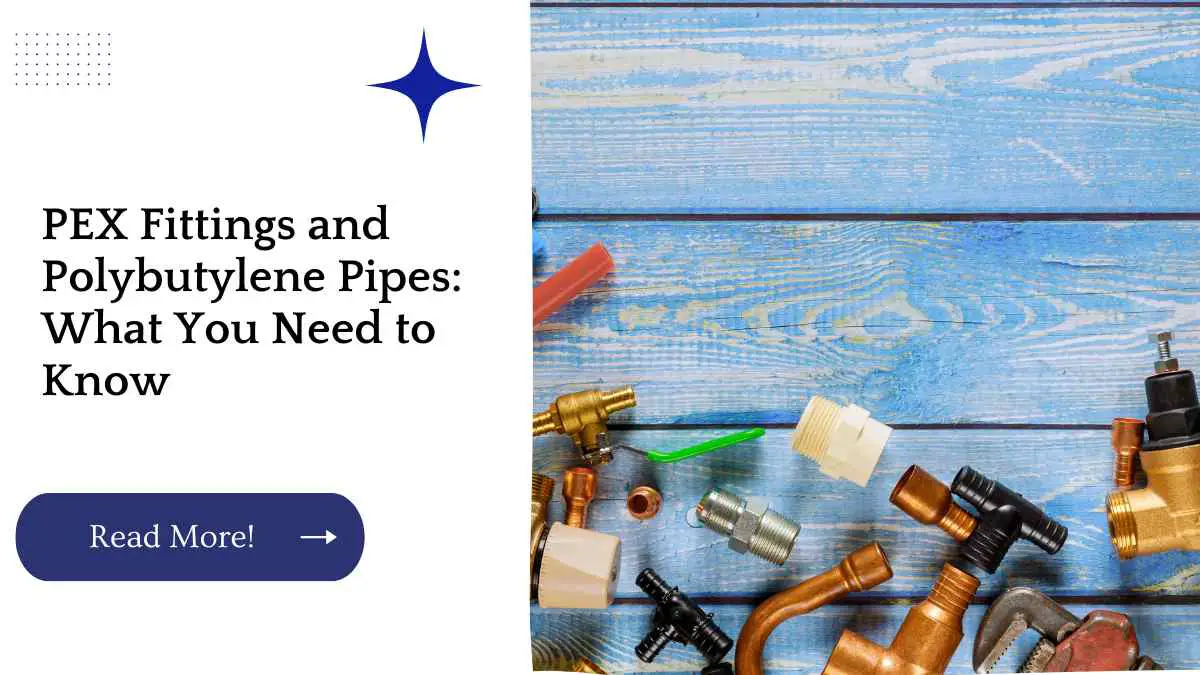Your plumbing system is essential for the proper functioning of your home. While you may not see them every day, the pipes and fittings that make up your plumbing system play a critical role in ensuring your home stays dry, warm, and functional. Two popular materials used in plumbing systems are PEX and polybutylene pipes.
| PEX Pipes | Polybutylene Pipes |
|---|---|
| Pros: resistant to corrosion, flexible, easy installation | Pros: low cost, easy installation |
| Cons: not suitable for outdoor use, can be affected by UV radiation | Cons: prone to cracking, potential for leaks |
| Identifying: marked with “PEX” or “PE” on pipe and fittings | Identifying: gray color, with “PB” or “Polybutylene” |
| Replace: if damaged or excessively aged | Replace: if experiencing leaks or other issues |
In this blog post, we’ll explore what these materials are, their advantages and disadvantages, and what you need to know if you have them in your home.
What is PEX?
PEX (cross-linked polyethylene) is a type of plastic that is commonly used in plumbing systems. PEX pipes are flexible, durable, and easy to install. They come in a variety of sizes and are often color-coded to indicate their intended use (e.g., red for hot water, blue for cold water).
Advantages of PEX Pipes
PEX pipes offer several advantages over other materials:
- Flexible: PEX pipes are highly flexible, which makes them easy to install and less likely to burst or crack in extreme temperatures.
- Durable: PEX pipes are highly resistant to corrosion and mineral buildup, which can extend their lifespan compared to other materials.
- Cost-effective: PEX pipes are generally less expensive than copper pipes, making them a popular choice for homeowners on a budget.
- Energy-efficient: PEX pipes have a lower thermal conductivity than other materials, which means they can help reduce heat loss and save on energy costs.
A refrigerator is one of the most important household appliances, and it’s crucial to make sure it’s running at peak performance. As we explain in our DIY refrigerator repair guide, proper care and maintenance can extend the life of your refrigerator and save you money in the long run.
Disadvantages of PEX Pipes
Despite their advantages, PEX pipes also have some potential drawbacks to consider:
- Not ideal for outdoor use: PEX pipes are not recommended for outdoor use, as exposure to UV light can degrade the material over time.
- May leach chemicals: Some PEX pipes have been known to leach chemicals into drinking water, although this is rare and usually only occurs in older or poorly installed systems.
- Can’t be recycled: PEX pipes are not recyclable, which can make them less environmentally friendly than other materials.
What are Polybutylene Pipes?
Polybutylene is a type of plastic resin that was commonly used in plumbing systems between the 1970s and 1990s. While polybutylene pipes were once popular due to their low cost and easy installation, they are now known to have some serious drawbacks.
A rusted toilet flange can lead to leaks, unpleasant odors, and even a damaged subfloor. If you need to replace your toilet flange, check out our step-by-step guide for a fool-proof fix that will keep your bathroom odor-free and structurally sound.
Advantages of Polybutylene Pipes
There are very few advantages to using polybutylene pipes in your plumbing system. However, here are a couple of reasons why they were once popular:
- Inexpensive: Polybutylene pipes were much cheaper than copper pipes, which made them an attractive option for homeowners on a budget.
- Easy to install: Polybutylene pipes were very easy to install, as they could be easily bent and curved around obstacles in the home.
Disadvantages of Polybutylene Pipes
Despite their low cost and easy installation, polybutylene pipes have some serious disadvantages that have led to their decreased popularity:
- Prone to leaks: Polybutylene pipes are highly prone to leaks and failures, especially at the connections between pipes and fittings.
- Subject to deterioration: Polybutylene pipes can become brittle and crack over time, especially when exposed to chlorine in municipal water supplies.
- Can cause water damage: When polybutylene pipes fail, they can cause significant water damage to your home and belongings.
How to Identify PEX and Polybutylene Pipes
If you’re not sure what kind of pipes you have in your home, there are a few ways to identify whether you have PEX or polybutylene pipes:
- Check the color: PEX pipes are often color-coded to indicate their intended use (e.g., red for hot water, blue for cold water). Polybutylene pipes, on the other hand, are usually gray or black.
- Inspect the fittings: PEX fittings are typically made of brass or plastic, while polybutylene fittings are usually made of copper or gray acetal.
- Look for a stamp: Some PEX pipes may have a stamp indicating the manufacturer and the ASTM standard used for the pipe. Polybutylene pipes may have a stamp indicating the manufacturer and the date of manufacture.
A toilet shut-off valve is an essential component of your plumbing system, but what happens when it doesn’t work? You could be facing a major emergency. Fortunately, there are simple fixes for a faulty toilet shut off valve that any homeowner can do themselves.
Replacing PEX and Polybutylene Pipes
If you have PEX or polybutylene pipes in your home and are considering replacing them, there are a few things to keep in mind:
- Hire a licensed plumber: Replacing plumbing pipes is a complex job that should only be done by a licensed and experienced plumber.
- Consider your options: If you have polybutylene pipes, it’s recommended to replace them as soon as possible due to their high failure rate. PEX pipes, on the other hand, can often be repaired rather than replaced.
- Be prepared for the cost: Replacing plumbing pipes can be expensive, especially if your home has multiple stories or hard-to-reach areas. However, the cost of repairing water damage caused by a plumbing failure can be even higher.
If you’re dealing with damaged shower drywall, it’s important to address the issue as soon as possible to prevent water damage from spreading. Our guide on fixing shower drywall provides step-by-step instructions for repairing drywall and preventing moisture from wreaking havoc on your home.
Further Reading
Here are some additional resources to learn more about PEX and polybutylene pipes:
PEX Fittings at SupplyHouse.com: This page offers a wide selection of PEX fittings for all your plumbing needs.
Connecting PEX to PB at SupplyHouse.com: This blog post explores the process of connecting PEX pipes to polybutylene pipes in your plumbing system.
Poly-B vs. PEX Piping at YourGuyPlumbing.ca: This article provides a detailed comparison of polybutylene and PEX piping, including their pros and cons and the cost of replacing them.
Conclusion
In conclusion, understanding the materials used in your plumbing system is important for maintaining the safety and functionality of your home. While PEX pipes offer several advantages over other materials, such as copper and polybutylene, they also have some potential drawbacks to consider.
Polybutylene pipes, on the other hand, are known to have a high failure rate and are not recommended for use in modern plumbing systems. If you’re not sure what kind of pipes you have in your home or are considering replacing them, it’s important to consult with a licensed and experienced plumber to ensure the job is done safely and correctly.
Low water pressure in your shower can be frustrating, but fortunately, it’s often an easy fix. Check out our simple tips for boosting shower pressure and enjoy a more powerful, invigorating shower experience today!
FAQs
Can PEX pipes be used for outdoor plumbing?
A: No, PEX pipes are not recommended for outdoor use as they can be degraded by exposure to UV light.
Can polybutylene pipes be repaired?
A: While it is possible to repair polybutylene pipes, it’s generally recommended to replace them due to their high failure rate.
Can PEX pipes be used for hot water?
A: Yes, PEX pipes can be used for hot water. In fact, they are often used for both hot and cold water applications.
Are PEX pipes safe for drinking water?
A: Yes, PEX pipes are considered safe for drinking water. However, some PEX pipes have been known to leach chemicals into drinking water, although this is rare and usually only occurs in older or poorly installed systems.
How much does it cost to replace plumbing pipes?
A: The cost of replacing plumbing pipes can vary depending on several factors, such as the size of your home, the type of pipes being replaced, and the accessibility of the plumbing system. However, it’s important to keep in mind that the cost of repairing water damage caused by a plumbing failure can be even higher.

Hellen James is the author of the blog and a licensed plumber with over 15 years of experience. She shares her knowledge and experience in plumbing and drainage through insightful and informative articles

